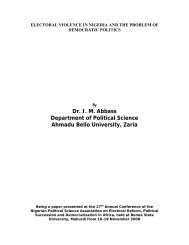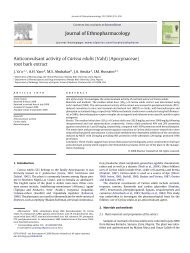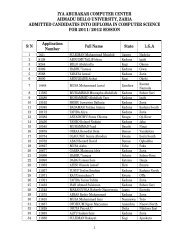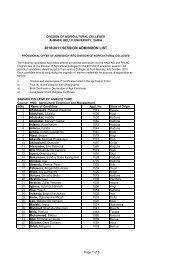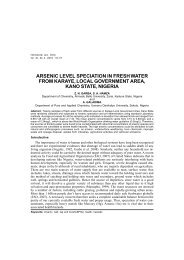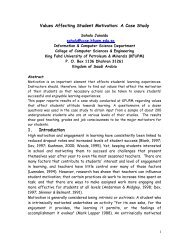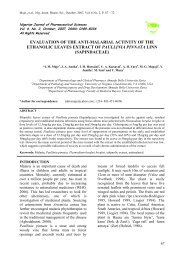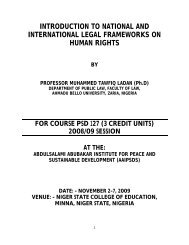Phytochemical screening and antibacterial activities of Vernonia ...
Phytochemical screening and antibacterial activities of Vernonia ...
Phytochemical screening and antibacterial activities of Vernonia ...
Create successful ePaper yourself
Turn your PDF publications into a flip-book with our unique Google optimized e-Paper software.
Acta Poloniae Pharmaceutica ñ Drug Research, Vol. 68 No. 1 pp. 67ñ73, 2011 ISSN 0001-6837Polish Pharmaceutical SocietyNATURAL DRUGSPHYTOCHEMICAL SCREENING AND ANTIBACTERIAL ACTIVITIESOF VERNONIA AMBIGUA, VERNONIA BLUMEOIDESAND VERNONIA OOCEPHALA (ASTERACEAE)ABUBAKAR B. ALIYU 1* , ALIYU M. MUSA 2 , MIKHAIL S. ABDULLAHI 3 , HAMISU IBRAHIM 1, 4<strong>and</strong> ADEBAYO O. OYEWALE 11Department <strong>of</strong> Chemistry, 2 Department <strong>of</strong> Pharmaceutical <strong>and</strong> Medicinal Chemistry,Ahmadu Bello University, Zaria-Nigeria3National Research Institute for Chemical Technology- Basawa, Zaria-Nigeria4School <strong>of</strong> Chemistry, Faculty <strong>of</strong> Science <strong>and</strong> Agriculture, Westville Campus, Private Bag X54001,University <strong>of</strong> Kwazulu Natal, Durban 4000, South AfricaAbstract: Some <strong>Vernonia</strong> species (<strong>Vernonia</strong> ambigua, <strong>Vernonia</strong> blumeoides <strong>and</strong> <strong>Vernonia</strong> oocephala) used inNorthern Nigerian traditional medicine, were subjected to phytochemical <strong>screening</strong> using st<strong>and</strong>ard procedures.The <strong>antibacterial</strong> activity using the disc diffusion method as outlined by the NCCLS was carried out onKlebsiella pneumoniae, Streptococcus pyogenes, Staphylococcus aureus, Corynbacterium ulcerans, methicillinresistant Staphylococcus aureus (MRSA), Salmonella typhi, Pseudomonas aeruginosa, Shigella dysentriae,Proteus mirabilis <strong>and</strong> Pseudomonas fluorescence. The results <strong>of</strong> the <strong>antibacterial</strong> activity as indicated by zone<strong>of</strong> growth inhibition ranged from 14 to 27 mm for the crude ethanol extracts <strong>and</strong> chlor<strong>of</strong>orm fractions <strong>of</strong> the<strong>Vernonia</strong> species being studied. The activity <strong>of</strong> chlor<strong>of</strong>orm fraction <strong>of</strong> V. blumeoides was higher on C. ulcerans<strong>and</strong> K. pneumoniae (27 mm), while the chlor<strong>of</strong>orm fractions <strong>of</strong> V. oocephala <strong>and</strong> V. ambigua were more activeon P. mirabilis (27 mm) <strong>and</strong> S. typhi (22 mm), respectively. It is worth <strong>of</strong> mention that the chlor<strong>of</strong>orm fractions<strong>of</strong> the three <strong>Vernonia</strong> species demonstrated activity (20 mm) against MRSA. The minimum inhibitory concentration(MIC) values ranged from 1.25ñ2.5 mg/mL for all the organisms tested. The MIC <strong>of</strong> 1.25 mg/mL exhibitedby the chlor<strong>of</strong>orm fractions on both Gram positive <strong>and</strong> negative bacteria indicates broad spectrum activity<strong>of</strong> the <strong>Vernonia</strong> species being studied. <strong>Phytochemical</strong> <strong>screening</strong> <strong>of</strong> the extracts/fractions revealed the presence<strong>of</strong> steroids/terpenes, saponins, flavonoids, alkaloids, tannins <strong>and</strong> glycosides. The <strong>antibacterial</strong> activity exhibitedin this study may be attributed to flavonoids, saponinss or sesquiterpene lactones. The overall results indicatethat the extracts/fractions are potent <strong>antibacterial</strong> preparations at least in vitro. This lends credence to theuse <strong>of</strong> these plants for the treatment <strong>of</strong> various infectious diseases.Keywords: phytochemical, <strong>antibacterial</strong> <strong>activities</strong>, <strong>Vernonia</strong> ambigua, <strong>Vernonia</strong> blumeoides, <strong>Vernonia</strong> oocephala,AsteraceaeThe use <strong>of</strong> plant continues to play essentialroles in traditional medicine for the treatment ormanagement <strong>of</strong> various human diseases, especiallyin rural Africa where infectious diseases are endemicdue to poverty <strong>and</strong> poor sanitations. In Ghana,Mali, Nigeria <strong>and</strong> Zambia, the first line <strong>of</strong> treatmentfor 60% <strong>of</strong> the children with high fevers, is the use<strong>of</strong> herbal medicines at home (1). The importance <strong>of</strong>plants in medicine remains even <strong>of</strong> greater relevancewith the current global shift to obtain drugs fromplant sources, as a result <strong>of</strong> which attention has beengiven to the medicinal value <strong>of</strong> herbal remedies forsafety, efficacy <strong>and</strong> economy (2, 3). Plants constitutean important source <strong>of</strong> active natural productswhich differ widely in terms <strong>of</strong> structure <strong>and</strong> therapeuticproperties. The continued investigation intothe secondary plant metabolites for anti-infectiveagents has gained importance in recent yearsbecause <strong>of</strong> the alarming increase in resistance <strong>of</strong>pathogenic microorganisms to existing antibiotics.For instance, the incidence <strong>of</strong> methicillin resistantStaphylococcus aureus (MRSA) continue toincrease tremendously across the globe <strong>and</strong> posesenormous therapeutic problems. In Nigeria, Kenya<strong>and</strong> Cameroon, the rate <strong>of</strong> MRSA spread was about21ñ30% in 2003 (4). However, prevalence rate <strong>of</strong>* Corresponding author: -mail: aliyubab<strong>and</strong>o@gmail.com; phone: +2348057371917, +234809816067467
<strong>Phytochemical</strong> <strong>screening</strong> <strong>and</strong> <strong>antibacterial</strong> <strong>activities</strong> <strong>of</strong> Veronia ambigua... 69Test for free anthraquinones (Bontragerís test)Small portion <strong>of</strong> the extract was shaken with10 mL <strong>of</strong> benzene <strong>and</strong> filtered. Five milliliters <strong>of</strong>10% NH 3 solution was added to the filtrate <strong>and</strong>stirred. The production <strong>of</strong> a pink-red or violet colorindicates the presence <strong>of</strong> free anthraquinones.Test for saponins (Frothing test)Small quantity <strong>of</strong> the extract was dissolved in10 mL <strong>of</strong> distilled water. This was then shaken vigorouslyfor 30 s <strong>and</strong> was allowed to st<strong>and</strong> for 30min. A honey comb formed for more than 30 minindicates saponins.Test for steroids <strong>and</strong> triterpenes (Lieberman-Burchardís test)Equal volume <strong>of</strong> acetic anhydride was added tothe extract. One milliliter <strong>of</strong> conc. H 2 SO 4 was addeddownside the tube <strong>and</strong> the color change wasobserved immediately <strong>and</strong> later. Red, pink or purplecolor indicates the presence <strong>of</strong> triterpenes while blueor blue-green indicates steroids.Test for flavonoids (Shinoda test)About 0.5 g <strong>of</strong> the extract was dissolved in 1.5mL <strong>of</strong> 50% methanol <strong>and</strong> warmed on steam bath.Metallic magnesium <strong>and</strong> 5 drops <strong>of</strong> concentratedhydrochloric acid were added. A red or orange colorindicates the presence <strong>of</strong> flavonoids aglycone.Test for tannins (Ferric chloride test)About 0.5 mL <strong>of</strong> extract was dissolved in 10mL <strong>of</strong> distilled water <strong>and</strong> then filtered. Few drops <strong>of</strong>ferric chloride solution were added to the filtrate.Formation <strong>of</strong> a blue-black precipitate indicateshydrolyzable tannins <strong>and</strong> green precipitate indicatesthe presence <strong>of</strong> condensed tannins.Test for alkaloids (Dragend<strong>of</strong>fís test)To about 0.5 g <strong>of</strong> each extract, 1% diluted HCl(20 mL) was added in a conical flask, heated on asteam bath <strong>and</strong> then filtered. The filtrate was madealkaline with 28% NH 3 solution <strong>and</strong> then extractedwith chlor<strong>of</strong>orm (3 ◊ 5 cm 3 ). The combined CHCl 3extracts were concentrated <strong>and</strong> treated with equalvolume <strong>of</strong> 1% HCl. Dragendorffís reagents (2 mL)were added <strong>and</strong> occurence <strong>of</strong> orange-red precipitateindicated the presence <strong>of</strong> alkaloids.Test organismsTen clinical bacterial strains: Klebsiella pneumoniae,Streptococcus pyogenes, Staphylococcusaureus, Corynbacterium ulcerans, methicillin resistantStaphylococcus aureus (MRSA), Salmonellatyphi, Pseudomonas aeruginosa, Shigella dysentriae,Proteus mirabilis <strong>and</strong> Pseudomonas fluorescencewere obtained from the Department <strong>of</strong>Microbiology, Ahmadu Bello University TeachingHospital (ABUTH) Shika. The isolates were purifiedon nutrient agar (OXOID) plates <strong>and</strong> characterizedusing st<strong>and</strong>ard microbiological <strong>and</strong> biochemicalprocedures (26, 27). The MRSA strains used inthis study were clinical isolates from urethral swab,seminal fluid, urine, high virginal swab, blood, skin<strong>and</strong> sputum <strong>of</strong> patients with symptoms <strong>of</strong> S. aureusassociateddiseases. The isolates were identified byst<strong>and</strong>ard method (26). The disc diffusion methodoutlined by the NCCLS (28) was used with 1 µgoxacillin disk (Oxoid). The zones <strong>of</strong> inhibition weremeasured after incubation at 35 O C for 24 h. Isolateswith zones diameter = 10 mm were consideredmethicillin resistant. The organisms were maintainedon agar slope at 4 O C <strong>and</strong> subcultured for 24 hbefore use.Determination <strong>of</strong> <strong>antibacterial</strong> activityThe disc diffusion method was used (29).Stock solution (100 mg/mL) <strong>of</strong> each extract <strong>and</strong>fractions were prepared using the extractants. Discs(6 mm diameter) were prepared using Whatman filterpaper <strong>and</strong> sterilized by autoclaving. The blanksterile discs were placed on the inoculated MuellerHinton Agar (MHA) surface <strong>and</strong> impregnated with15 µL <strong>of</strong> stock solutions (1500 µg/dics). Antibioticdiscs <strong>of</strong> ampiclox (75 µg/dics) <strong>and</strong> streptomycin (30µg/dics) were used as positive control, whereas discs<strong>of</strong> the extracting solvents were used as negative control.The plates were incubated at 37 O C for 24 h. Alltests were performed in triplicate <strong>and</strong> the <strong>antibacterial</strong><strong>activities</strong> were expressed as the mean diameter <strong>of</strong>inhibition zones (mm) produced by the plantextracts.Minimum inhibitory concentration (MIC)The minimum inhibitory concentration (MIC)was determined using micro-broth dilution methodsas outlined by NCCLS (30). Dilutions (1ñ9mg/mL) <strong>of</strong> concentrations <strong>of</strong> extract <strong>and</strong> fractionsthat exhibited sensitivity against the test organismswere prepared using test tubes containing 9 mL <strong>of</strong>double strength broth. The test tubes were inoculatedwith the suspension <strong>of</strong> the st<strong>and</strong>ardized inocula.These were incubated at 37 O C for 24 h <strong>and</strong>observed for growth. The minimum inhibitory concentrations(MICs) <strong>of</strong> the extracts/fractions foreach test organism were regarded as the lowestconcentration that inhibited visible growth <strong>of</strong> thetest organisms.
70 ABUBAKAR B. ALIYU et al.Table 1. <strong>Phytochemical</strong> <strong>screening</strong> <strong>of</strong> extracts.Plant constituent<strong>Vernonia</strong> ambigua <strong>Vernonia</strong> blumeoides <strong>Vernonia</strong> oocephalaEE CF EE CF EE CFAlkaloids + + + + + +Flavonoids + + + + + +Saponins + ñ + ñ + ñTannins + - + ñ + ñSteroids/terpenes + + + + + +Anthraquinones ñ ñ ñ ñ ñ ñGlycosides + ñ + ñ + ñEE = ethanol extract, CF = chlor<strong>of</strong>orm fraction, + = positive, <strong>and</strong> ñ = negativeTable 2. Antibacterial susceptibility test.Zone <strong>of</strong> inhibition <strong>of</strong> growth (mm)V. ambigua V. blumeoides V. oocephalaTest organismsEE CF EE CF EE CFAmpiclox(75µg/dics)Streptomycin(30 µg/disc)S. aureus 18 20 22 24 18 20 20 27MRSA 14 20 17 20 20 20 NT NTS. pyogenes 16 18 16 18 16 24 0 22C. ulcerans 16 19 24 27 20 22 NT NTS. typhi 20 22 18 20 0 0 0 0S. dysenteriae 0 0 14 18 0 0 NT NTP. mirabilis 0 0 0 0 22 27 NT NTP. aeruginosa 18 20 0 0 0 0 26 0P. fluorescence 0 0 0 0 0 0 NT NTK. pneumoniae 16 19 22 27 20 25 0 20EE = ethanol extract, CF = chlor<strong>of</strong>orm fraction, MRSA = methicillin resistant Staphylococcus aureus, NT = not testedRESULTS<strong>Phytochemical</strong> <strong>screening</strong> revealed the presence<strong>of</strong> alkaloids, flavonoids, saponins, tannins,steroids/terpenes <strong>and</strong> glycosides in the crudeextracts/fractions <strong>of</strong> the <strong>Vernonia</strong> samples.However, saponins, tannins <strong>and</strong> glycosides werefound absent in the chlor<strong>of</strong>orm fractions <strong>of</strong> all thesamples. Anthraquinones were absent in theextracts <strong>and</strong> fractions <strong>of</strong> all the three <strong>Vernonia</strong>plants being investigated (Table 1). The results <strong>of</strong>the <strong>antibacterial</strong> <strong>activities</strong> showed that the plantextracts/fractions exhibit remarkable activityagainst the test organisms (C. ulcerans, K. pneumonia,Staphylococcus aureus, P. mirabilis, S. typhi, S.dysentriae, MRSA <strong>and</strong> P. aeruginosa) with zone <strong>of</strong>growth inhibition ranging from 14 to 27 mm. Thesusceptibilities <strong>of</strong> P. aeruginosa, S. dysentriae <strong>and</strong>P. mirabilis were only found in each case to theextract/fraction <strong>of</strong> V. ambigua, V. blumeoides <strong>and</strong> V.oocephala, respectively. The MIC values rangedfrom 1.25ñ2.5 mg/mL for all the organisms tested(Table 3). P. fluorescence was, however, resistant tothe extracts/fractions <strong>of</strong> all the <strong>Vernonia</strong> samples(Table 2).DISCUSSION AND CONCLUSION<strong>Phytochemical</strong> <strong>screening</strong> <strong>of</strong> plant products orextracts aimed to evaluate the <strong>antibacterial</strong> propertiesmay be <strong>of</strong> immense importance in the discovery<strong>of</strong> new therapeutic agents, especially at this timewhen the scientific community is preoccupied withsearching for alternative treatment to combat the
<strong>Phytochemical</strong> <strong>screening</strong> <strong>and</strong> <strong>antibacterial</strong> <strong>activities</strong> <strong>of</strong> Veronia ambigua... 71Table 3. Determination <strong>of</strong> minimum inhibitory concentration (MIC).Minimum inhibitory concentration (mg/mL)Test organisms <strong>Vernonia</strong> ambigua <strong>Vernonia</strong> bluemoides <strong>Vernonia</strong> oocephalaEE CF EE CF EE CFS. aureus 2.5 1.25 1.25 1.25 2.5 1.25MRSA 2.5 1.25 2.5 1.25 1.25 1.25S. pyogenes 2.5 2.5 2.5 2.5 2.5 1.25C. ulcerans 2.5 2.5 1.25 1.25 1.25 1.25S. typhi 1.25 1.25 2.5 1.25 NT NTS. dysenteriae NT NT 2.5 2.5 NT NTP. mirabilis NT NT NT NT 1.25 1.25P. aeruginosa 1.25 1.25 NT NT NT NTK. pneumoniae 2.5 2.5 1.25 1.25 1.25 1.25EE = ethanol extract, CF = chlor<strong>of</strong>orm fraction, MRSA = methicillin resistant Staphylococcus aureusincreasing threat <strong>of</strong> drug resistant microorganisms.The result <strong>of</strong> <strong>antibacterial</strong> evaluation <strong>of</strong> the aerialpart <strong>of</strong> <strong>Vernonia</strong> ambigua, <strong>Vernonia</strong> blumeoides <strong>and</strong><strong>Vernonia</strong> oocephala showed that the chlor<strong>of</strong>ormfractions were more active than the crude ethanolextracts against the test organisms (Table 2).Difference in polarity <strong>of</strong> solvents is perhaps responsiblefor the difference in solubility <strong>of</strong> plant activeprinciples. It means that the <strong>antibacterial</strong> agent(s)have concentrated in the chlor<strong>of</strong>orm fractions hencevariation in degree <strong>of</strong> activity. The susceptibility <strong>of</strong>C. ulcerans <strong>and</strong> K. pneumonia to chlor<strong>of</strong>orm fraction<strong>of</strong> V. blumeoides demonstrate higher (27 mm)<strong>antibacterial</strong> activity in terms <strong>of</strong> growth inhibition <strong>of</strong>the test organisms. It is interesting to note that theethanol extract <strong>and</strong> chlor<strong>of</strong>orm fraction <strong>of</strong> V.oocephala, as well as the chlor<strong>of</strong>orm fractions <strong>of</strong> V.ambigua <strong>and</strong> V. blumeoides, demonstrated good<strong>antibacterial</strong> activity against the MRSA. The significance<strong>of</strong> this outcome is the efficacy at which thefractions demonstrate the observed activity, whichmay be a milestone in the continued search <strong>and</strong>development <strong>of</strong> newer drugs or phytotherapeuticagents against the MRSA.The ethanol extracts <strong>and</strong> chlor<strong>of</strong>orm fractions<strong>of</strong> the <strong>Vernonia</strong> species demonstrated activityagainst both Gram negative (P. aeruginosa, S. typhi,S. dysentriae <strong>and</strong> P. mirabilis) <strong>and</strong> Gram positivebacteria (S. aureus, C. ulcerans <strong>and</strong> S. pyogenes)(Table 2). The susceptibility <strong>of</strong> P. aeruginosa to onlythe extract <strong>and</strong> fraction <strong>of</strong> <strong>Vernonia</strong> ambigua may bea pointer to its potential as a drug against this organism.Infections caused by Pseudomonas speciessuch as mastitis are <strong>of</strong>ten difficult to combat (31).The fact that P. mirabilis was susceptible to only theextract/fraction <strong>of</strong> V. oocephala indicates the potency<strong>of</strong> the plant against diseases caused by the organism(Table 2). Proteus mirabilis is a pathogenicGram-negative bacterium that frequently causes kidneyinfections, typically established by ascendingcolonization <strong>of</strong> the urinary tract (32, 33). The organismproduces a variety <strong>of</strong> unique virulence factorsthat contribute to its pathogenicity <strong>and</strong> persistence inthe human host (34).Low MIC indicates the minimum inhibitoryconcentration required to inhibits the growth <strong>of</strong> thetest organism, which translate to high potency <strong>of</strong> theextract or fraction. The MIC <strong>of</strong> 1.25 mg/mL exhibitedby the chlor<strong>of</strong>orm fractions on both Gram positive<strong>and</strong> negative bacteria indicates broad spectrumactivity <strong>of</strong> the <strong>Vernonia</strong> species being studied. Theorder <strong>of</strong> potency was: V. oocephala > V. blumeoides> V. ambigua (Table 3). The results <strong>of</strong> our findingscompared or even surpassed the report <strong>of</strong> <strong>antibacterial</strong>activity <strong>of</strong> bark extracts <strong>of</strong> V. tenoreana whichexhibits MICs <strong>of</strong> 10, 15 <strong>and</strong> 20 mg/mL for varioustest organisms (35). Similar report revealed the <strong>antibacterial</strong>potency <strong>of</strong> active leaf extract <strong>of</strong> V. amygdalinawith MICs <strong>of</strong> 22.5ñ26.0 mg/mL <strong>and</strong>19.8ñ26.4 mg/mL for the Gram-negative <strong>and</strong> Grampositiveisolates tested (36). Owing to their popularuse as remedies for many infectious diseases, plantswith secondary metabolites such as alkaloids,saponins, terpenoids, flavonoids, sesquiterpene lactones<strong>and</strong> steroids have been found to have antimicrobialproperties in vitro (37ñ39). Thus higher <strong>antibacterial</strong>activity exhibited by the chlor<strong>of</strong>orm fractionsin this study may be attributed to flavonoids orsteroids/terpenes. These major chemical constituentshave been identified <strong>and</strong> characterized
72 ABUBAKAR B. ALIYU et al.from most <strong>Vernonia</strong> species (40ñ44). Although themechanisms <strong>of</strong> action <strong>of</strong> bioactive constituents <strong>of</strong>the <strong>Vernonia</strong> species being studied may be difficultto speculate; however, many <strong>antibacterial</strong> agentsmay exhibit their action through inhibition <strong>of</strong> nucleicacid, protein <strong>and</strong> membrane phospholipidsbiosynthesis (45). It is probable that the <strong>antibacterial</strong>agent(s) in the fractions <strong>of</strong> the <strong>Vernonia</strong> might actvia some <strong>of</strong> the above mechanisms.The overall results indicate that the extracts<strong>and</strong> fractions are potent <strong>antibacterial</strong> preparations atleast in vitro. However, in vivo evaluation may berequired to ascertain that active concentrations <strong>of</strong>the extract when absorbed may remain bioactive forthe time to completely kill the pathogens. Furtherphytochemical <strong>and</strong> pharmacological studies arechallenging task in order to better underst<strong>and</strong> theeffects <strong>of</strong> these important pharmaceutical resources.Plants <strong>of</strong> the <strong>Vernonia</strong> genus (Asteraceae) mayprove to be a rich source <strong>of</strong> compounds with potentialantimicrobial <strong>activities</strong>. Bioactivity guided isolation,purification, characterization <strong>and</strong> structuralelucidation <strong>of</strong> the active constituents from the<strong>Vernonia</strong> species is on-going in our laboratory.AcknowledgmentThe authors acknowledged the contribution <strong>of</strong>the authority <strong>of</strong> Ahmadu Bello University, Zaria, forproviding the facilities for conducting this research.REFERENCES1. World Health Organization (2003) TraditionalMedicine. http://www.who.int/mediacentre/factsheets/fs134/en/print.html2. Glombitza K.W., Mahran G.H., Mirhom Y.W.,Michael K.G. Motawi T.K.: Planta Med. 60,244 (1993).3. Mahabir D., Gulliford M.C.: Rev. Panam. SaludPublica. 1, 1 (1997).4. Kesah C., Ben-Redjeb S., Odugbemi T.O.,Boye C.S.B., Dosso M., Ndinya-Achola J.O.,Koulla-Shiro S. et al.: Clin. Microb. Infect. 9,153 (2003).5. Onanuga A., Oyi A.R., Onaolapo J.A.: Afr. J.Biotechnol. 4, 1321 (2005).6. Mirza S.H., Beeching N.J., Hart C.A.: J. Med.Microbiol. 44, 317 (1996).7. Mulvey M.R., Bryce E., Boyd D., Ofner-Agostini M., Christianson S., Simor A.E., PatonS.: Antimicrob. Agents Chemother. 48, 1204(2004).8. Rhomberg P.R., Fritsche T.R., Sader H.S.,Jones R.N.: Microbiol. Infect. Dis. 56, 57(2006).9. Hoban D.J.: Antimicrob. Agents Chemother.52, 1430 (2008).10. Wilson C.O., Gisvold O., Doerge R.F.: Textbook<strong>of</strong> Organic Medicinal <strong>and</strong> PharmaceuticalChemistry. 6 th edn., pp. 34ñ37, Lippincot Co.,Philadelphia 1971.11. Nwaogu L.A., Alis C.S., Ibegbulem C.O., IgweC.U.: Afr. J. Biotechnol. 6, 890 (1971).12. Akah P.A.; Okafor C.L.: Phytother. Res. 6, 171(1992).13. Akah P.A., Ekekwe R.K.: Fitoterapia 66, 352(1995).14. Akinpelu D.A.: Fitoterapia 70, 432 (1999).15. Iwalokun B.A.: Afr. Health Sci. 8, 25 (2008).16. Rasoanaivo P., Petitjean A., Ratsinanmanga-Urvers S., Rakoto-Ratsimamanga A.: J.Ethnopharmacol. 37, 117 (1993).17. Olorode O.: Taxanomy <strong>of</strong> West African FloweringPlants, 1 st edn., pp. 98-100, Longman,London 1984.18. Krishna Kumari G.N., Masilamani S., GaneshM.R., Aravind S., Sridhar S.R., Zaluzanin D.:Fitoterapia 74, 479 (2003).19. Kuo Y.H., Kuo Y.J., Yu A.S., Wu M.D., OngC.W., Yang Kuo L.M. et al.: Chem. Pharm.Bull. 51, 425 (2003).20. Koul J.L., Koul S., Singh C., Taneja S.C.,Shanmugavel M., Kampasi H. et al.: PlantaMed. 69, 164 (2003).21. Huang Y., Ding Z.H., Liu J.K.: Z. Naturforsch.[C] 58, 3470 (2003).22. Tchinda A.T., Tane P., Ayafor J.F., ConnollyJ.D.: Phytochemistry 63, 841 (2003).23. Nergard C.S., Diallo D., Michaelsen T.E.,Malterud K.E., Kiyohara H., Matsumoto T. etal.: J. Ethnopharmacol. 9, 141 (2004).24. S<strong>of</strong>owora A.: Medicinal Plants <strong>and</strong> TraditionalMedicine in Africa. p. 289, Spectrum BooksLtd., Ibadan 1993.25. Evans W.C.: Trease <strong>and</strong> Evans Pharmacognosy.15 th edn., pp. 191ñ193, 513ñ540, W.B. Saunders,Sydney/Toronto 2002.26. Cowan S.T., Steel K.F.: Manual forIdentification <strong>of</strong> Medical Bacteria. 2 nd edn., pp.97ñ115, Cambridge University Press, London1974.27. McFaddin J.F.: Biochemical Tests forIdentification <strong>of</strong> Medical Bacteria. pp.392ñ452, Williams <strong>and</strong> Wilkins Co., Baltimore1977.28. NCCLS: Performance St<strong>and</strong>ards AntimicrobialDisc Susceptibility Tests. Approved St<strong>and</strong>ard,
<strong>Phytochemical</strong> <strong>screening</strong> <strong>and</strong> <strong>antibacterial</strong> <strong>activities</strong> <strong>of</strong> Veronia ambigua... 73Fifth edn., NCCLS Document M2-A5,Villanova, PA, USA 1993.29. Nostro A., Germano M.P., DíAngelo V.,Marino A., Cannattelli M.A.: Lett. Appl.Microbiol. 30, 379 (2000).30. NCCLS: Methods for Dilution AntimicrobialSusceptibility Tests for Bacteria That GrowAerobically; Approved St<strong>and</strong>ard Fifth edn.,NCCLS Document M7-A5, NCCLS, Wayne,PA, USA 2000.31. Salie F., Eagles P.F.K., Leng H.J.M.: J.Ethnopharmacol. 52, 27 (1996).32. Rubin, R. H., Tolk<strong>of</strong>f-Rubin, N. E., CotranR.S.: In The Kidney (Brenner, B.M., Rector,F.C. Eds. , pp. 1085ñ1141, W. B. Saunders Co.,Philadelphia 1986.33. Rauprich O., Matsushita M., Weijer C.J.,Siegert F., Esipov S.E., Shapiro J.A.: J.Bacteriol. 178, 6525 (1996).34. Coker C., Poore C.A., Xin L., Mobley H.L.T.:Microbes Infect. 2, 1497 (2000).35. Ogundare A.O., Adetuyi F.C., AkinyosoyeF.A.: Afr. J. Biotechnol. 5, 1663 (2006).36. Iwalokun B.A., Bamiro S.B., Durojaiye O.O.:West Afr. J. Pharmacol. Drug Res. 19, 9 (2003).37. Cowan M.M.: Clin. Microbiol. Rev. 12, 564(2002).38. Sib<strong>and</strong>a T., Okoh A.I.: Afr. J. Biotechnol. 6,2886 (2007).39. Cartagena E., Montanaro S., BardÛn A.: Rev.Latinoamer. QuÌm. 36, 43 (2008).40. Oligashi H., Jisaka M., Takagaki, T., Tada, T.,Huffman, MA, Nishida T. et al.: Agric. Biol.Chem. 55, 1201 (1991).41. Jisaka, M., Oligashi, H., Tagekawa, K.,Huffman, MA, Koshimizu, K.: Biosci. Biotech.Biochem. 57, 833 (1993).42. Igede, G.O., Oleszek, W., Jurzysta, M., Burda,S., Fanfunso, M., Fasanmade, A.A.: J. Agric.Food Chem. 42, 2445-2448 (1994).43. Geraldo de Carvalho M., Mir<strong>and</strong>a da Costa P.,Abreub H.: J. Braz. Chem. Soc. 10, 163 (1999).44. Kuo Y., Kuo Y., Yu A., Wu M., Ong C., Yangkuo L., Huang J., Chen C., Li S.: Chem. Pharm.Bull. 51, 425 (2003).45. Fraklin T.J., Snow G.A., Barrett-Bee K.J.,Nolan R.D.: Biochemistry <strong>of</strong> antimicrobialaction. Fourth edn., pp. 71-73, 112, Chapman<strong>and</strong> Hall, London 1987.Received: 4. 08. 2009


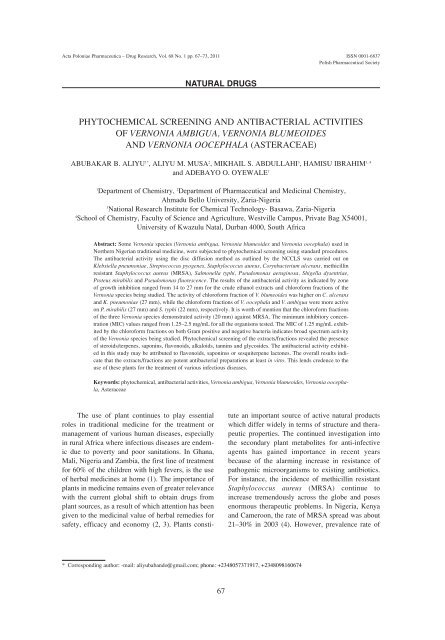
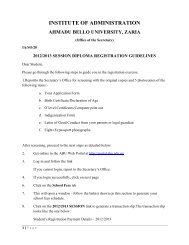
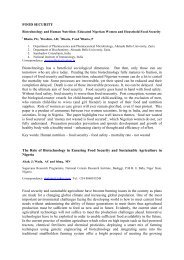

![Full Paper [PDF]](https://img.yumpu.com/49740055/1/184x260/full-paper-pdf.jpg?quality=85)
